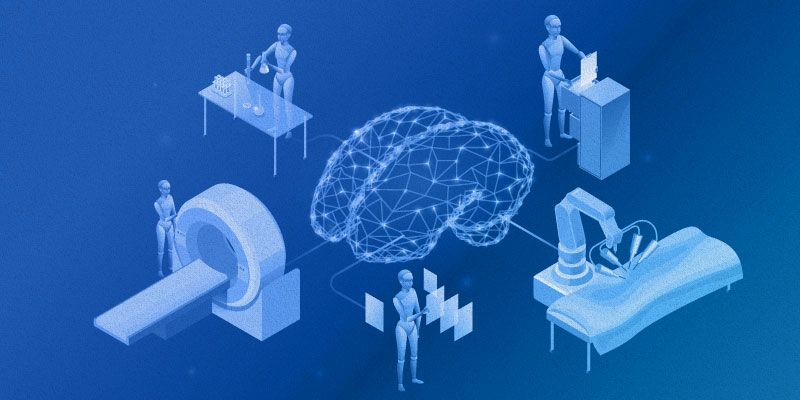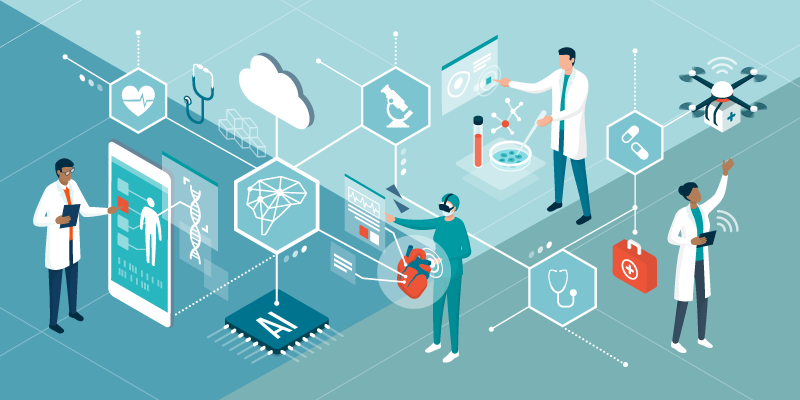Machines that think and talk like us may once have been possible only in the realm of science fiction. In 1950, all that changed when British mathematician Alan Turing created the Turing test, still in use today, to determine a machine’s ability to “think” like a human. Popularly considered the catalyst for the Fourth Industrial Revolution, the adoption and development of Artificial Intelligence (AI) was driven by the vision to teach machines to perform sophisticated mental tasks, interact like humans, process natural language, perceive the way humans do and display ‘human’ traits like emotional intelligence, intuition, and creativity.
Today, AI has impacted every aspect of our lives. One area that has seen significant advancement is healthcare. According to a recent report published by Artificial Intelligence in Healthcare Market, AI in the healthcare market was valued at $2.62 billion globally in 2018 and is expected to grow to $44.24 billion by 2026, at a CAGR of 49.8 percent from 2019 to 2026. Whether it is the identification and treatment of an ailment to post-treatment care, AI has enabled the development of multiple innovative approaches and discoveries. It has helped reimagine the way healthcare professionals approach their patients by offering more bespoke treatment options.

One key differentiator in the game has been the advent of Big Data. The availability of data gathered from various sources, which include medical records and smart devices, has helped accelerate biomedical research efforts outside the more traditional clinical trial settings. AI will have a far-reaching impact as it leverages algorithms and offers insights that are more precise and accurate as they interact with training data, to deliver better diagnoses, prescriptions, and custom treatments, thereby delivering better outcomes.
AI for real-world challenges
But it’s not just diagnostics and treatment that has been positively impacted. Today, AI is powering numerous ancillary services as well, from research and building medical tools to administration and even humanitarian efforts. Just imagine the effect that can have as the world grapples with one of the biggest health crises of our lifetimes. Here are some of the key areas where AI is making a mark. And this is just the tip of the iceberg.

Drug research: AI can study vast databases of existing drugs and identify attributes to help redesign therapies that can target specific symptoms. And all this in less than a fraction of the time it would take a human researcher to achieve. Just imagine the impact this can have on success rates, ensuring that more effective drugs reach the market faster when they are needed the most.
Identifying risks: Access to vast amounts of historic patient data helps doctors identify higher-risk patients. This could range from identifying those more susceptible to heart disease, cancer, lifestyle or genetic diseases, to even those demographics that are more likely to fall ill during a pandemic.
Efficient archives: While electronic records simplified the drudgery of paperwork to a large extent, cognitive overload, having to organise archives, etc. were still posing significant challenges. The use of AI has helped create interfaces that are intuitive and automate mundane tasks. This could include prescription refills, appointment reminders and test results.
Drug resistance alerts: Drug resistance has seen a disturbing rise, and claims thousands of lives each year when people are exposed to bugs and viruses even in a ‘sanitised’ setting. AI can help identify high-risk patients even before they show symptoms.
Accurate imaging: AI is helping pathologists by providing better imaging, leading to a better diagnosis. The ability of AI to narrow down on pixels allows doctors to identify nuances that even the naked eye would miss. It can also direct the attention to important details.
Reaching the underserved: Across the world, many communities lack access to more advanced medical facilities. AI can fill this gap by taking on diagnostic functions. Several studies have shown that AI medical facilities not only improve healthcare access in rural areas, but also replace clinical staff.
Regulatory challenges
But with all these advantages, there are certain challenges that need to be overcome. The first and most obvious is privacy and data ownership. With patient information being so confidential, regulators need to set clear rules about whether hospitals should be allowed to share data, even if it’s anonymous, with AI companies. This comes into focus with General Data Protection Regulation (GDPR) coming into force, which allows patients to delete their data in special circumstances, and the penalties that defaulting companies could incur.
The second challenge comes with the quality of the data generated. Given that medical information can be unstructured and sometimes inaccurate (a patient could lie about alcohol consumption, smoking or even be unaware of family medical history).
The third challenge is liability. Should anything go wrong, who is responsible in case of misdiagnosis and can AI companies be held accountable?
However, one thing is clear. With more chronic diseases, the current pandemic, and an increasingly ageing population in most countries (India is an exception), innovation in healthcare and AI solutions may be a step in the right direction.
How has the coronavirus outbreak disrupted your life? And how are you dealing with it? Write to us or send us a video with subject line 'Coronavirus Disruption' to editorial@yourstory.com
Link : https://yourstory.com/2020/05/shot-arm-ai-disrupt-healthcare-space
Author :- Madhurima Agarwal ( )
May 19, 2020 at 04:53PM
YourStory RSS Feed
